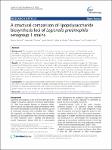A structural comparison of lipopolysaccharide biosynthesis loci of Legionella pneumophila serogroup 1 strains
Petzold, Markus
Thürmer, Alexander
Menzel, Susan
Mouton, Johan W.
Heuner, Klaus
Lück, Christian
Background: The lipopolysaccharide (LPS) is the major immuno-dominant antigen of all Legionella species including L. pneumophila. Its diversity is the basis for the classification of L. pneumophila into serogroups and monoclonal subgroups and is thought to be involved in strain specific virulence. The understanding of the genetic basis of the LPS-antigen is incomplete. Thus, we analyzed the genetic locus involved in LPS-biosynthesis of L. pneumophila serogroup 1 (Sg1) strains with the focus on strain specific gene composition. Results: The LPS-biosynthesis loci of 14 L. pneumophila Sg1 strains comprise two distinct regions: A 15 kb region containing LPS-biosynthesis genes that can be found in all L. pneumophila strains and a Sg1-specific 18 kb region. The 15 kb region is highly conserved among Sg1 strains as reflected by high homologies of single ORFs and by a consistent ORF arrangement. In contrast, the Sg1 specific 18 kb region is variable and partially disrupted by phage related genes. We propose that the region spanning from ORF 6 to ORF 11 of the Sg1-specific region is likely involved in late LPS-modification. Due to the high variability of this small region and various combinations of single ORFs within this region a strain specific LPS-structure could be synthesized including modifications of legionaminic acid derivates. Conclusions: Our data clearly demonstrate that the gene structure of the LPS-biosynthesis locus of L. pneumophila Sg1 strains show significant interstrain variability. These data can be used for further functional analysis of the LPS synthesis to understand pathogenesis and reactivity with monoclonal antibodies. Moreover, variable but strain specific regions can serve as basis for the development of novel genotyping assays.
No license information

